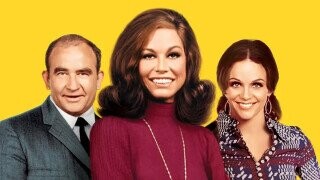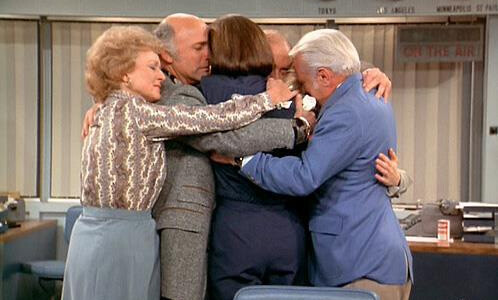15 Trivia Tidbits About ‘The Mary Tyler Moore Show’

Click around on every big Best Sitcoms in History list online, and you’re bound to find The Mary Tyler Moore Show near the top. After all, we might never have had shows like Friends, Frasier, 30 Rock and Girls if it weren’t for CBS producing their groundbreaking comedy during a time of civil rights activism and second-wave feminism. The 1970s was regarded as a revolutionary time, and seeing a show about a single woman named Mary Richards navigating her single life as an associate producer of a news station in Minneapolis was a push of the envelope — and a push in the right direction.
Here are some spunky tidbits about the sitcom with a string of spin-offs (thanks to its smorgasbord of unforgettable characters) and the female-led show that dared to suggest that a woman could be successful without a man by her side…
Click right here to get the best of Cracked sent to your inbox.
The Theme Song Was Unsolicited
The show’s famous theme song, “Love Is All Around,” was written by Sonny Curtis, who learned about the new CBS show through a friend working for an entertainment agency. This pal sent Curtis a synopsis of the show, and he got to writing. “I honed in on the part that she rented an apartment that she had a hard time affording,” he once told CBS Sunday Morning. That is where the lines “How will you make it on your own? / This world is awfully big, girl this time you’re all alone” came from.
Curtis then met with executive producer James L. Brooks who told him that they weren’t ready to choose a theme song yet, but that didn’t stop Curtis from pulling out his guitar and performing the song for Brooks. “He smiled and said, ‘Sing that again,’” Curtis remembered. “There was a black telephone on the floor, and he got on that telephone and started calling people, and I had to sing it about 10 times before I left that afternoon. The room was full of people standing all around the walls.”
Mary Was Originally Going to Be Divorced
CBS initially wanted to fire co-producers Allan Burns and Brooks, arguing that the two newbies didn’t have the skills to write and produce a groundbreaking urban show. Some of it had to do with the fact that they originally wanted their main character, Mary Richards, to be a recent divorcee, which CBS didn’t like at all. “You have to remember that, back in the early 1970s, divorce wasn’t taken so lightly,” Moore said in the documentary, The Making of Season One — The Mary Tyler Moore Show. “Neither by the two people in the marriage, nor by the audience watching the show about divorced people.”
She explained that CBS didn’t think there’d be anything funny about the theme of divorce. The network was also worried that, given Moore’s claim to fame as the wife of Rob Petrie on The Dick Van Dyke Show, audiences would think she was divorcing Dick Van Dyke.
It’s Widely Believed to Be the First Show to Talk About ‘The Pill’
A controversial topic for the 1970s, it’s believed that the show was the first to address single women taking birth control. The Pill itself was only made available to singletons in 1972 after the Supreme Court ruled that everyone should have access to it. As The New York Times put it: “Had the Pill ever been mentioned in a sitcom script before Mary Tyler Moore? If so, the moment has been lost to history.”
How positively risqué. Then again, the show also featured Mary having sex out of wedlock, much to conservatives’ horror. Not only did The Mary Tyler Moore Show have its finger on the pulse, but it was, after all, the product of a sitcom with an unprecedented number of female writers on its payroll, sharing their own experiences to create an authentic female-centric sitcom.
Gordy’s Race Was Never Brought Up
John Amos was cast to play Gordy Howard, the WJM newsroom’s weatherman, and the actor gave credit to the writers for not turning his race into a talking point or a gag. “The thing that was really clever about The Mary Tyler Moore Show casting of me as Gordy the Weatherman was that the subject of Gordy’s race never came up,” Amos said during his Inside TV Land interview. “And I thought that was a very healthy attitude for the writers and the producers to take.”
Mary’s Apartment Became a Big Tourist Attraction

While Mary’s fictitious address was 119 North Weatherly in Minneapolis, the exterior shots were that of a real house at 2104 Kenwood Parkway. Folks started showing up to the address in droves, much to its occupants’ surprise. “This house, Mary’s house, turned out to be Minnesota’s version of Graceland,” the house’s occupant, Mr. Maurer, told The New York Times in 1995. Maurer and his wife had never seen the show and were somewhat annoyed when folks would either park on their lawn to throw their hats in the air or insist that Mary really did live there.
The woman who used to live in the house when the show first aired hilariously draped the entire place with huge signs that screamed “Impeach Nixon” when the producers returned to film more exterior footage.
Mary Tyler Moore Wasn’t Sure About Ed Asner
Asner, who played executive producer Lou Grant, told Kelly Clarkson that he passed his first audition and had to go in again to read with Moore. The producers asked him to do precisely what he did the first time around, but Asner couldn’t remember what that was. According to him, he went in “all mashugana” and did the scene, only to learn years later that Moore asked the producers afterward, “Are you sure?”
Gavin MacLeod Was Originally Up for the Character of Lou Grant
The producers initially wanted MacLeod for the part of Grant, but MacLeod was interested in playing Mary’s co-worker Murray Slaughter, instead. So he auditioned for Grant but then asked if he could do Murray in his second round — specifically the character’s opening scene in the show (watch at 4:10 below).
Of course, he nailed it and got the part. Moore said that Murray was supposed to be Mary’s nemesis at work, but after casting MacLeod in the role — who was so “filled with exuberance and warmth” — they changed his character, making him Mary’s friend at the station.
The Unsolved Murder of the Actress Who Played Sherry
Barbara Colby was so good at playing Sherry, a sex worker, in the episode “Will Mary Richards Go to Jail?” that they brought her back as a parolee in search of a job. Sherry tries her hand at fashion and presents Mary with that infamous green dress.
Colby even got a part in one of the show’s spin-off series, Phyllis, but after filming just three episodes, she and a male colleague were gunned down while walking in Venice, California. Robbery was ruled out as a motive, and the case remains unsolved.
Betty White Was Only Going to Be in One Episode
White’s appearance in Season Four as Sue Ann Nivens, the star of The Happy Homemaker show on the news network, was supposed to be a one-off. The role was initially described in the script as a “Betty White type” character, which led the producers to see if they could get the real actress for the part. White was such a hit that Brooks told her, “Don’t make too many plans.” She stayed on until the series finale.
Ted Knight Was Nothing Like the Ted Baxter the Producers Had Envisioned
No one thought that Knight was the right actor to play the bumbling news anchor who didn’t know how to say words like “London.” Moore described the original concept of Ted Baxter as “a tall, dark and handsome — fall-down handsome — love interest” for Mary Richards, and Knight didn’t fit the type. The producers initially wanted John Aniston (Jennifer Aniston’s father) to play the part. Knight, however, made everyone laugh hysterically during his auditions and even bought his character’s distinct blue blazer on his last dime to show his commitment to the role.
Valerie Harper Was Found Doing a Play at a Small Theater
Struggling to find the right actress to play the delightful Rhoda Morgenstern, CBS casting director Ethel Winant went to see some theater shows in search of Mary’s bestie. Harper was doing a little play called An American Nightmare in a tiny theater, and Winant knew that she was the perfect actress to portray “impossible Rhoda.” The casting director, however, struggled to get Harper’s information — she wasn’t affiliated with SAG and didn’t have an agent yet — but Winant’s secretary finally managed to locate Harper’s whereabouts, and Harper aced her audition.
The Show’s Finale Influenced the Finale of ‘Friends’

NBC
When the show about a group of friends who can somehow afford amazing apartments in NYC had to wrap things up, the producers looked to the 1970s sitcom for guidance. Co-creator Marta Kauffman called the show the “gold standard” of sitcom finales, even though co-producer Allan Burns said that they only knew about The Mary Tyler Moore Show coming to an end two days before the finale was filmed.

CBS
The Show Had Many Successful Spin-Offs
Rhoda was the first spin-off show that ran from 1974 to 1978, winning both Golden Globes and Emmys. Phyllis aired between 1975 and 1977, and Asner got his own drama series titled Lou Grant that ran for five years, earning both him and the show an entire Wikipedia page of coveted awards. Asner, however, said in his final interview that he had way more fun doing The Mary Tyler Moore Show.
About That Famous Hat Throw in the Show’s Opening Sequence

CBS
Moore told Diana Sawyer that the hat was a present from her aunt and that someone eventually stole it. She also revealed that the opening sequence was filmed on the coldest morning in Minneapolis. While everyone was freezing, the director said to her, “You know what would be a good idea, Mary? Go out in the middle of the intersection and take that tam off and throw it in the air.”
The actress said that it was so cold she couldn’t produce a single word in protest. “So I did as I was told, and dear Hazel Frederick (the unknowing extra in the back), who was frozen forever in the background, looking with what appears to be a scowling face at me, and she told me later, because I did meet her, that it was just that she had no idea what was going on, never saw a camera. She just thought there was a lunatic about to lose her life.”
A CBS Special Landed Mary Tyler Moore Her Own Show
Following The Dick Van Dyke Show, the actress didn’t have much success with her follow-up projects. That is until she was asked to join Van Dyke on a CBS 1969 special called Dick Van Dyke and the Other Woman. The network immediately offered Moore her own show based on that special, and history was made.